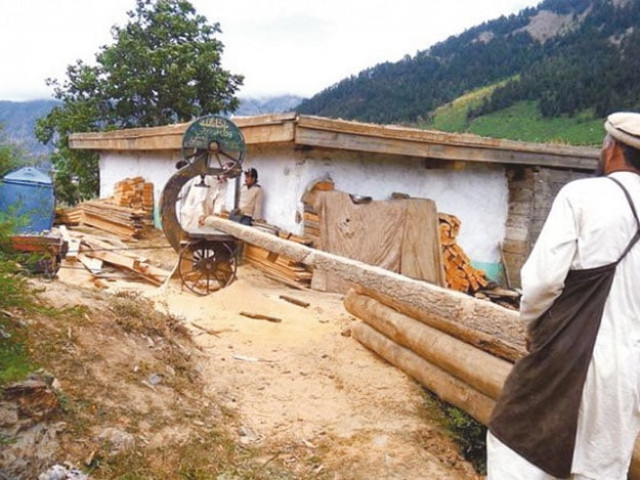Poor planning not deforestation to blame for devastation
If deforestation alone were responsible for floods, then how do we explain Karachi's crisis?

Pakistan inherited the legacy of British Forestry institutional and legal framework. Khyber-Pakhtunkhwa (K-P) holds 40% of the country's forest share, making it the richest province in this respect.
Within K-P, 14.1% of the total land area is covered with forests. The northern, north-western, and eastern parts of K-P are steep and mountainous, making them highly vulnerable to erosion and landslides.
Yet, these forests provide freshwater to major rivers running from north to south of the country. They also offer habitat for biodiversity, promote tourism, preserve natural beauty, and stabilise climate impacts on humans and other species.
Forests act as the lungs of Pakistan by absorbing carbon dioxide and supplying oxygen through carbon sequestration. They balance the environment in both time and space. Beyond these services, they provide food, shelter, fruit, and livelihoods. Forestry plays many roles in stabilising nature, but flood and erosion control is one of the most vital.
Forests and their ecosystems stabilise soil and protect it from erosion. The K-P forest department, working with local communities, forest landowners, and other stakeholders, carries out plantation drives twice a year during spring and monsoon seasons.
Major programmes include the Tarbela watershed plantation, social and farm forestry, Kalam integrated forestry, and the Billion and Ten Billion Tree plantation drives. Recently, the Green Pakistan Programme was also launched.
Hundreds of thousands of acres have been planted and protected through natural regeneration. Some of these projects received technical and financial support from the World Bank, WFP, GIZ, KFW, USAID, FAO, Dutch agencies, and UN organisations, while others were locally supported.
The Billion Tree programme was entirely funded by K-P, while the Ten Billion and Green Pakistan initiatives were financed jointly by the provinces and the federation.
Pakistan gained significant recognition for these pioneering projects, particularly the Billion and Ten Billion Tree programmes. They helped the country achieve the Bonn Challenge; restoring 150 million hectares of degraded and deforested land by 2020 and targeting 350 million hectares by 2030. These efforts brought international goodwill and respect for Pakistan's commitment to forestry.
Despite these achievements, the recent floods in K-P sparked criticism, with some blaming deforestation for the devastation. Most critics, however, are either non-professionals or using the argument for point-scoring.
Monsoon rains have been part of the region's history for centuries, and the north-eastern parts of K-P regularly receive heavy showers. Flood disasters are not unique to Pakistan, India, China, and other regional countries also face similar challenges.
Forests do reduce the intensity of rainfall by intercepting drops, but steep terrain, surface runoff, and soil saturation often result in flash floods regardless. Trees are living entities with life cycles, and their timber supports many needs at an economically viable age.
Exploitation beyond carrying capacity poses risks, but the forest department is already regulating usage under forestry laws. Importantly, Pakistan also achieved its first carbon credits in the forestry sector for mangrove restoration in Sindh.
If deforestation alone were responsible for floods, then how do we explain Karachi's crisis? With less than two days of rain, life in the city is paralysed, schools close, offices shut, and people face severe losses. Karachi is flat and barely above sea level, yet devastation is immense.
In contrast, K-P has endured downpours for nearly two weeks. This contrast highlights the real culprits: unplanned infrastructure and obstruction of natural waterways.
Blaming forests or climate change alone oversimplifies the issue. Climate change is indeed a pressing factor, but it is often discussed superficially.
A look back at the Ice Age reveals that CO2 once fell below 190 ppm, with the lowest levels at 182 ppm. Below 150 ppm, most terrestrial plants could not survive. This shows that while global warming beyond tolerable limits is dangerous, some degree of warming is essential for life on Earth. Human responsibility for pushing warming beyond safe thresholds cannot be ignored.
Most natural forests in K-P belong to local communities but are managed by the forest department. The International Union for Conservation of Nature (IUCN) reports that only 7% of forests are government-owned, while 93% belong to people and communities.
Legal forest categories in K-P include reserved forests, which are government-owned, and protected or Guzara forests, which belong to local people but are managed by the department. Community and private forests also exist.
In the early 1970s, the K-P forest department-initiated tree plantations and soil conservation on private grazing lands in the Tarbela watershed. Agreements with landowners allowed planting of trees and soil conservation to reduce erosion and prolong Tarbela reservoir's life.
Accusing the forest department alone for deforestation is therefore unjustified, since most forests belong to communities. Still, under law, the department must manage them to protect ecosystems. Property rights, community ownership, and open access make management highly challenging.
Another obstacle is the sheer scale of forest areas, which are open and boundary-less, unlike urban banks that are heavily guarded yet still robbed. Expecting forest staff to control vast, open lands without strong governance structures is unrealistic.
Thus, the issue goes deeper than forestry staff or tree cover. It is about poverty, community rights, and governance. Policymakers must recognise these ground realities.
Strengthening forest protection requires supporting local communities, reducing poverty-driven dependence on forests, and improving management practices. Only then can K-P's forests be safeguarded while also minimising flood risks.
THE WRITER HOLDS A PHD IN FORESTRY AND IS A CLIMATE CHANGE, FORESTRY, AND ENVIRONMENT EXPERT




















COMMENTS (3)
Comments are moderated and generally will be posted if they are on-topic and not abusive.
For more information, please see our Comments FAQ